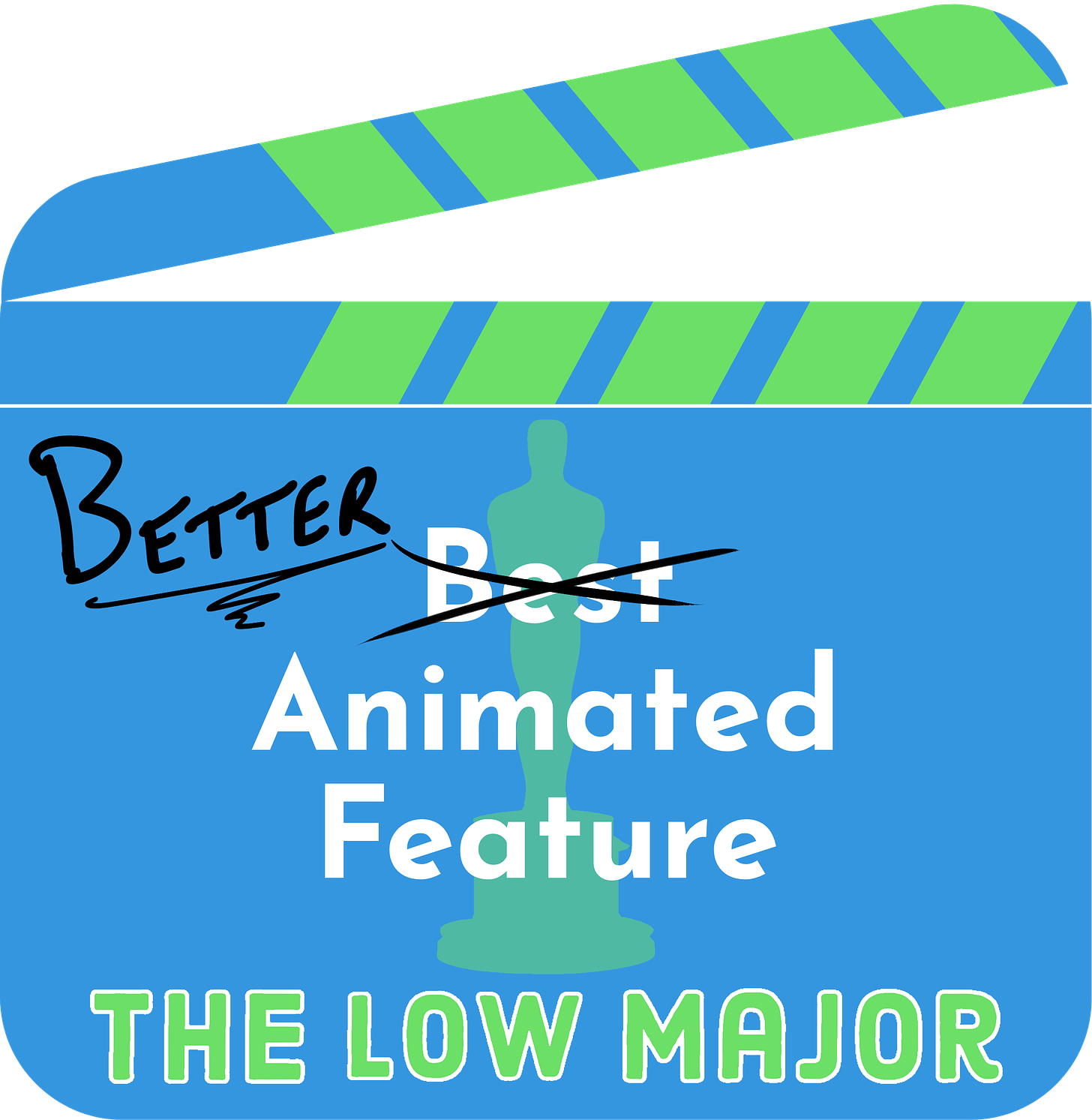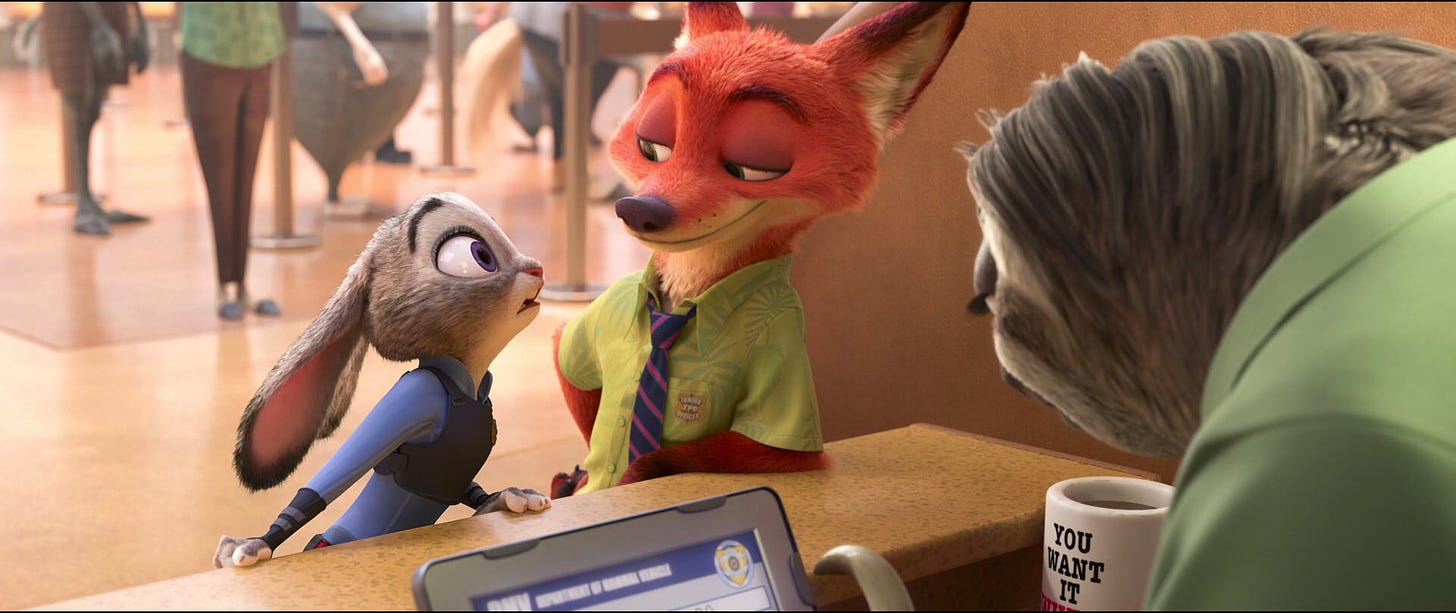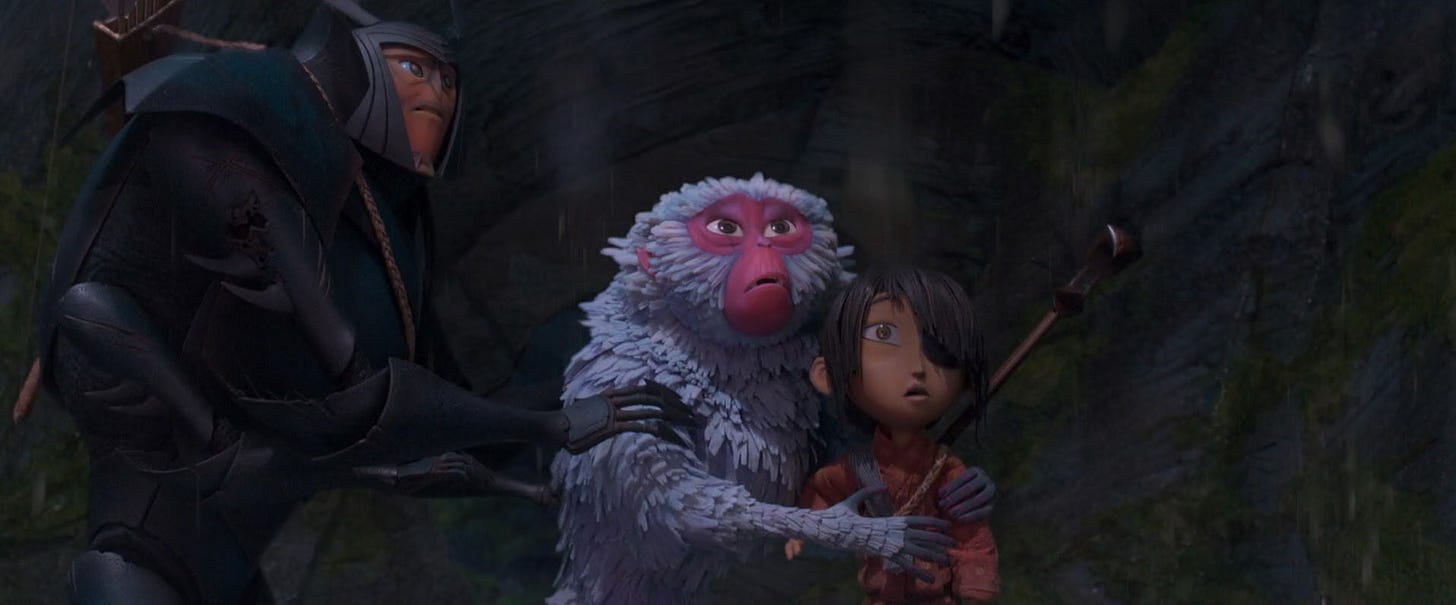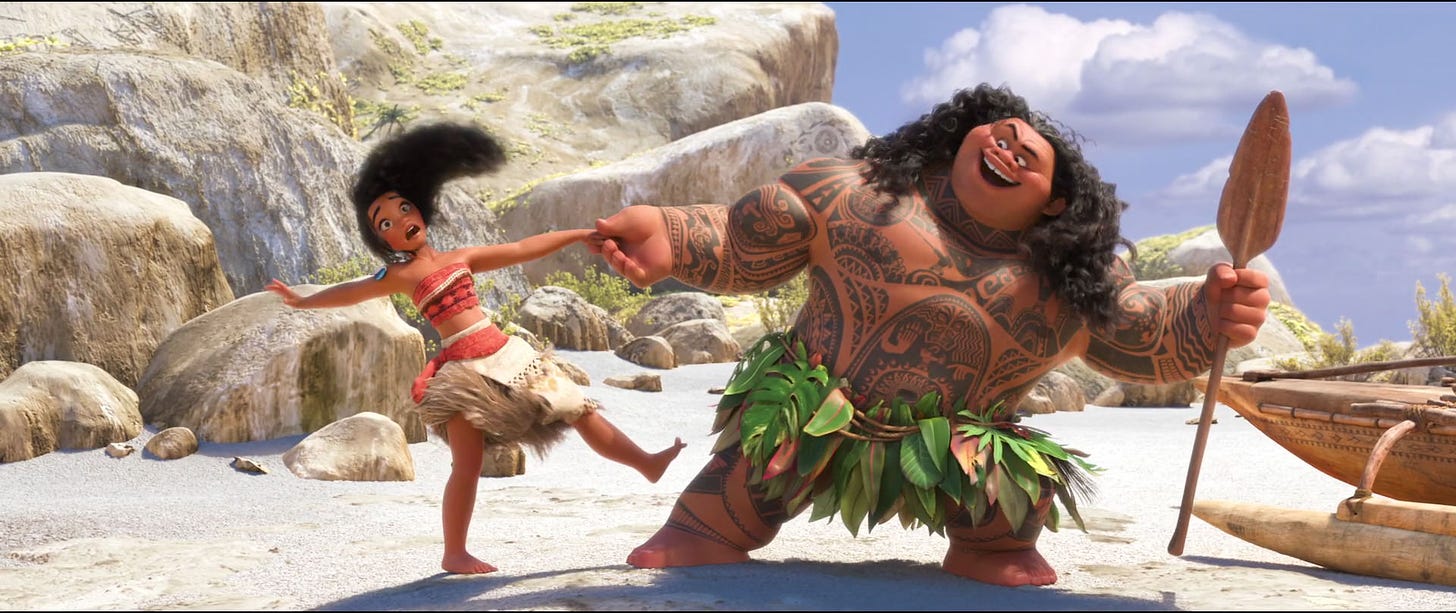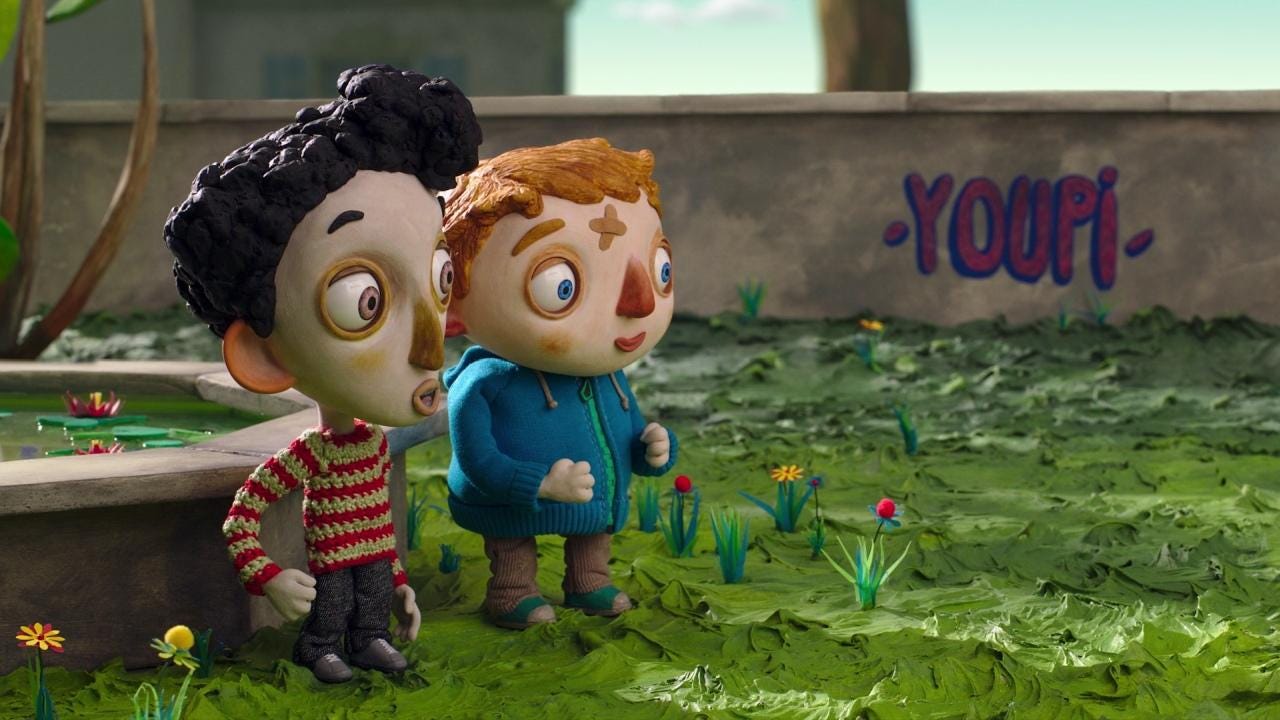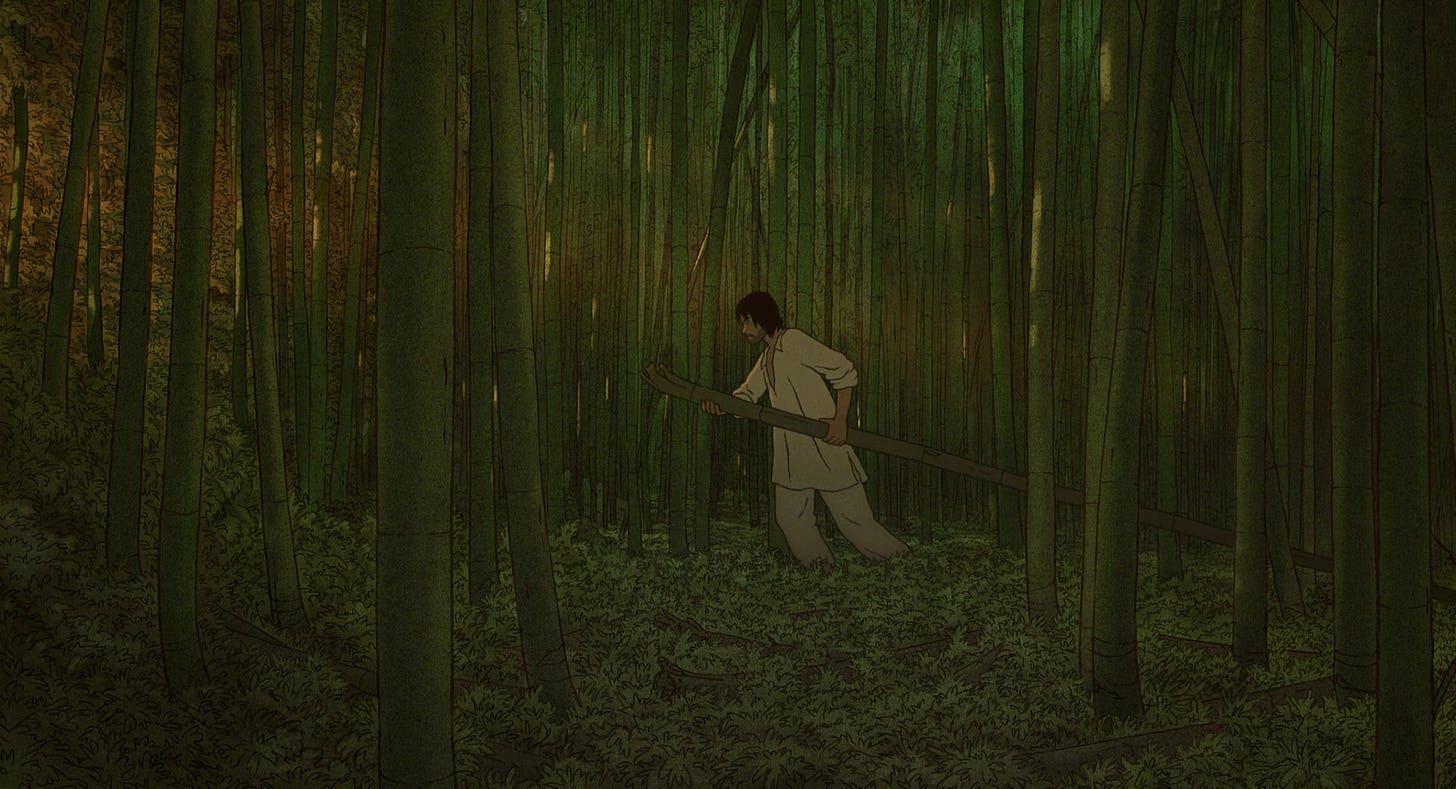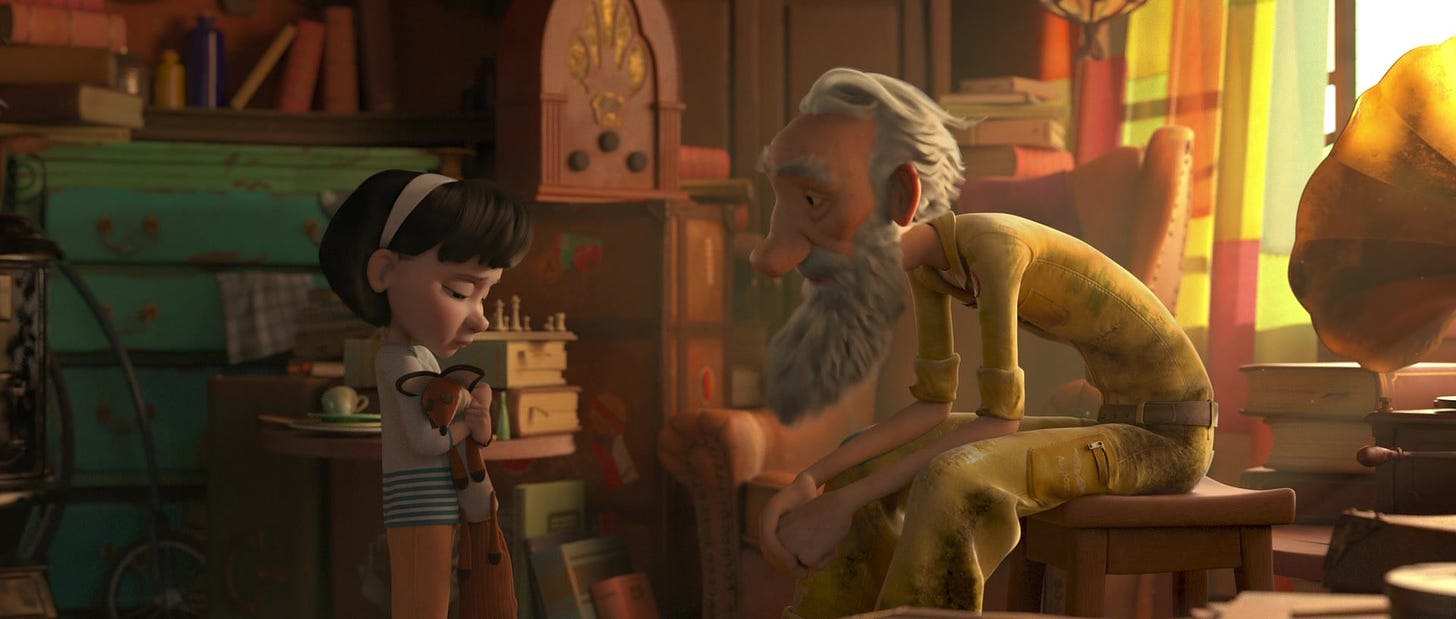Better Animated Feature: 2016
The bottom fell out this year and Disney took advantage. Did they deserve their trophy?
This post may be too long for email. We recommend clicking through to the website for the best experience.
Eli: 2016 was a deeply unserious year for animation, and I mean that in the most literal way. Across the animation landscape, studios seemed to be trolling left and right—and I’m not just talking about DreamWorks’ Trolls (which released this year but missed a nomination). DreamWorks also gave us Kung Fu Panda 3, a big disappointment compared to the second movie, while Pixar gave us the unnecessary Finding Dory. Blue Sky spat out another Ice Age film everyone forgot.1 That awful Illumination duo I ranted about in the 2010 piece, The Secret Life of Pets and Sing, both came out this year. The Angry Birds Movie: 2016. Remember Sausage Party? 2016. This year was brutal.
Given all that, it’s no surprise Disney got two nominations this year, and perhaps even less of a surprise that one of them won. But was it the correct one? And was it better than the other, less unserious contenders from all over the world?
I bet you’ll find out if you scroll down.
The Nominees
Zootopia (won Best Animated Feature)
Kubo and the Two Strings (nominated)
Moana (nominated)
My Life as a Courgette (nominated)
The Red Turtle (nominated)
The Little Prince (snubbed)
The “Best” Animated Feature: Zootopia
Leah: As The Low Major’s biggest fan of anthropomorphic fiction, I figured I should be the one to write about Disney’s modern take on the genre. Eli agreed that I should write this section for a different reason: in addition to being the biggest anthro animal fan at TLM, apparently I’m also the most discourse-brained.
Zootopia certainly is a film that lends itself to discourse. It follows protagonist Judy Hopps on her journey as the first bunny cop in Zootopia, a metropolitan paradise for mammals of all stripes. However, all is not harmonious in Zootopia. As a smaller prey animal, Judy is judged by her appearance and finds herself in a space that was not designed with animals like her in mind. In fact, stereotypes about both predator and prey seem to run rampant throughout the city. Before Judy leaves for the city, her parents give her “fox spray” and tell her to watch out for foxes. You can probably guess which animal ends up being her co-star. She meets a fox named Nick Wilde and wrangles him into helping her solve the mystery of disappearing predators in Zootopia, something Judy has staked her career on.
The film makes some pretty unsubtle parallels to racism in the human world. (Only bunnies can call other bunnies cute, it’s rude to touch a sheep’s hair, an elephant shop owner refusing to serve a fox on the basis of species without outright saying it, I could go on.) However, the allegory of prejudice between the species has some odd implications when trying to apply it toward the way racism works in the real world.
It’s not an original idea to say that predators and prey don’t really work as a metaphor for the human concept of race. Human race is purely a social construct, while predators and prey have some pretty obvious biological differences. Predators being inherently dangerous to prey in the real world also carries some unfortunate implications if you’re trying to portray predators as the subject of discrimination.
That also touches upon the other issue with Zootopia’s treatment of racism. In our world, white supremacy drives racism, one group systemically giving itself advantages and power at the expense of the other groups. In Zootopia, there’s no parallel to white supremacy driving racial discrimination. At different points in the movie, both predators and prey are portrayed as being unfairly stereotyped and discriminated against. It’s a fine message to say, “don’t judge others based on their appearance or discriminate based on fear of the other,” but in real life, those are symptoms of racism, not causes. It’s disingenuous to make a movie about racism and imply that the reason racism exists is because people can’t accept other people’s differences. It’s completely disconnected from how racism functions in the real world. The allegory fails.
Putting away the analysis of the allegory and the themes, it is a very fun buddy cop movie. Watching Judy and Nick travel through the different sections of Zootopia to unravel the mystery of the missing predators is fun. They have great chemistry as leads, and both of them have solid character arcs as they learn to work together and appreciate each other’s differences.
I also have to commend the care and artistry that went into designing Zootopia. They put thought into how a city full of anthropomorphic animals would actually function. Different-sized doors on the train for different-sized mammals, aquatic routes for animals that swim, a tiny section of the city designed for mice—all of these details worked to create a believable setting for a world of animal people. It was fun getting to see the different ecosystems within the city, environments that could accommodate a wide range of mammals, giving us plenty of fun characters throughout the film.
Zootopia winning doesn’t surprise me since it was well-crafted at a technical level, and a Disney movie examining racism at this level is pretty noteworthy. Whether you think it did a good job handling the subject matter or not, it did get people thinking critically about racism, which is a bit more ambitious thematically than a lot of the other Disney movies we’ve covered over the course of this project. At the same time, did Zootopia’s messy racism metaphor unfairly draw attention away from other films with artistic merit?
Let’s take a look.
The Other Animated Features
Kubo and the Two Strings — Leah
Nominated
LAIKA is the Best Animated Feature equivalent of “always the Bridesmaid, never the bride”; every film they’ve ever made has been nominated but none of them have ever won. Kubo and the Two Strings is yet another movie in their filmography that was good enough to be nominated, but not able to beat out Disney (or Pixar). So how good is Kubo exactly?
Kubo and the Two Strings follows the titular Kubo, a 12-year-old boy with a shamisen. He has a bit of family drama, with his grandfather being the Moon King who stole his left eye and also wants to steal his right eye. His mother tells him never to stay out after dark to protect him from both his grandfather and his aunts. Kubo accidentally stays out too late one night, attracting the attention of his mother’s family. His mother uses the last of her magic to protect him, allowing Kubo to escape and go seek out his father’s armor.
Kubo and the Two Strings is a touching story that deals with loss and grief and how those feelings are a key part of the human experience. The narrative is well crafted and the central characters are also compelling. The movie delivers a fun, fantastical adventure and a heartfelt emotional arc for the protagonist.
This film also shows off LAIKA’s stop-motion prowess. There’s so much to love visually in this movie. The scene where Kubo uses his shamisen to magically manipulate the paper into origami is super impressive from a visual perspective. The giant skeleton monster made for an exciting scene, and I think doing stop-motion at that scale is quite admirable. Everything, from the setting to the character designs, is well crafted. Stop-motion isn’t dethroning CGI any time soon, but this movie is evidence for what it can do as a medium if given the chance.
When comparing Kubo to Zootopia, I’m struck by how well-crafted Kubo’s story is and how thematically consistent it is as a film. Zootopia has a fun story and an excellent setting, but it struggles thematically with its predator-prey allegory for race. I would label Zootopia the more fun of the two films, but Kubo is the film with more substance. I can understand why someone would enjoy watching Zootopia more, but I don’t think the narrative holds up. Kubo’s themes and story are expertly intertwined in a way Zootopia’s just aren’t. Zootopia has a lot going for it artistically, with high quality animation and imaginative visuals, but I don’t think that alone is enough to justify calling it a better film. There’s an element of subjectivity to this, so maybe others will find that case more convincing, but to me, the heart of Kubo and the Two Strings wins the day.
Verdict: Better Animated Feature
Moana — Eli
Nominated
2016 was firmly within the period of my life when I ignored most animation, so this project marks the first time I've seen either Zootopia or Moana. I wasn't going into either completely blind; I’m actually not sure how big a rock you'd have to be living under for that to be the case.
I don't know how hot of a take this is in the grand scheme of things, but I was perfectly whelmed by Moana. I quite enjoyed the music, but I expected more from just about everything else.
My main issue is with the screenplay, which I found both messy and bland, a hard combination to achieve by accident. The first act takes place entirely on the island, with Moana’s father being your typical overbearing parent, then Moana runs away at the end of the first act to fulfill her destiny and the movie pretty much forgets about the island and all of its characters—the ones it spent some 30 minutes building up—until the falling action. That leaves Moana and Maui to go on a linear adventure that takes place mostly on the open sea, with hardly any tricks up its sleeve and no B plot to shake things up. (Some callbacks to the island would have done wonders here.) Most of the story beats between Moana and Maui feel undercooked, as does the resolution back on the island. It feels like maybe a second draft.
I don't mean to be the “7.8/10: too much water” guy, but if I'm comparing this to Zootopia, the difference is night and day. For all its flaws, that movie was action-packed, exciting to follow, and had so many fun, distinct set pieces that made me want to just jump through the screen and explore the city of Zootopia myself. If asked which of these movies I'd prefer to rewatch, I’d pick Zootopia in a heartbeat.
But that doesn't necessarily mean I think it's a better movie. In Pixar terms, I'd rather rewatch Cars 2 than A Bug’s Life even though Cars 2 is one of the most wretched productions Disney has ever brought to life. And while I wouldn't go as far as calling Zootopia “wretched”, it's hard for me to ignore that every time I think of this movie, my initial reaction is negative. It is perhaps the most discourse-inducing animated movie of the entire decade, and its concept is so ill-conceived, its allegories so poorly thought out, that I’m doomed to remember how much it broke my brain every time I look back at how fun it was to watch.
Meanwhile, despite being pretty bored by Moana when music wasn't playing, my gut response to it is positive. I'll either get a song (usually “You're Welcome”) stuck in my head or I'll smile at Disney managing not to screw up a movie about a racial minority group in any game-breaking ways. Moana could have been a lot better than it is, but the version we got still has a ton going for it.
To me, the direct comparison between these two movies is the Battle of Mid. In an average year, I would say neither of these films deserved the award (though I haven't seen any of the other 2016 nominees, so I can't speak on this year in particular). That said, if I do have to pick one, I have a hard time endorsing Zootopia. Everyone knows the best way to win is by default.
Verdict: Better Animated Feature
My Life as a Courgette — Leah
Nominated
My Life as a Courgette2 does more in its 70-minute runtime than a lot of movies do with double that. Through watching all these movies, I’ve seen several different approaches to pacing and narrative and gotten a sense of what is typical for animated movies, and this movie impressed me in a way that I can’t say any other nominee has. These smaller productions are often constrained by a shorter runtime, but My Life as a Courgette felt complete.
My Life as a Courgette opens up by showing Icare, the protagonist of the film, playing with beer cans. The unfolding scene makes it clear that Icare’s mother is an alcoholic and his father has left their family. After he accidentally makes a mess sending the cans he was playing with down the stairs, his mother angrily comes up to scold him, threatening to spank him. Afraid, Icare shuts the attic door on her as she comes up. Her character isn’t shown directly after that, but the film gives enough information for the viewer to fill in the blanks that the fall killed her. The next scene shows Icare talking to a police officer about what happened. When the officer calls him Icare, he makes it clear that he’d rather be called Courgette, a nickname his mother called him. The office takes him to a home for children like him and promises to visit him. The majority of the film is set there, as Courgette meets the other children and develops relationships with them.
Most of us have probably seen a story featuring an evil orphanage and a poor, abused child trapped there, but this movie inverts that concept. The people running the home are shown to be genuinely caring about the children living there. The children themselves have been through horribly traumatic life events, but grow through their relationships with each other. Even though all these horrible things happened to them, they have hope through their environment and their relationships with each other and the stable adults around them.
The art direction of the film made it very memorable. I loved the character designs for the children. It was a good blend of cute and unsettling, which fits the tone of the movie quite well. The stop-motion style of animation also worked well for this film, bringing these characters to life.
This is another case of a nominee being quite different from the eventual winner. However, one similarity I can point to is that both My Life as a Courgette and Zootopia are about modern social issues. I’ve already covered Zootopia’s messy racism allegory, but My Life as a Courgette takes a more literal approach to its subject matter. This is a story about kids without parents (or at least parents that are incapable of taking care of them). The things that happened to these children are things that happen to children in real life, and things that have a very real, very negative impact on their lives. My Life as a Courgette gives a narrative that calls to real tragedies that we see in our own communities and shows us a picture of how the children in these circumstances cope, how caring adults can make a difference, and that hope is possible even after horrible things happen. Zootopia, on the other paw, is very disconnected from our world, to the point of it distracting from the main themes of the film.
My Life as a Courgette may not have had a big Disney budget, a fantastical urban setting, or funny talking animals, but it did have a lot of heart and a lot to say about some of society’s most vulnerable members. Not only that, but it was also a hopeful movie. It didn’t just stop at showing us these kids' lives and saying “look at how awful their lives are,” but also showed us how their lives could get better, and how they could find hope without being too cheesy or sugarcoating reality. I think that alone is something that few films pull off, and it makes it really stand out to me among the dozens of the movies I’ve watched over the course of this project. I think that alone is enough to make worthy of being a:
Verdict: Better Animated Feature
The Red Turtle — Preston
Nominated
That The Red Turtle, a film produced with Studio Ghibli’s involvement, is beautiful hardly comes as a surprise. Of course giving such a renowned animation studio free rein to paint endless portraits of gorgeous sand, sea, and sky—usually featuring anything else, including all the movie’s characters, only minimally within the shot—would produce stunning results. And the detail animation, when it does come to the fore, is just as strong as we know to expect; it’s arguably some of the most expressive work Ghibli has ever done, a key reason that this dialogue-free film doesn’t feel like it’s missing a single word anywhere.
But Ghibli’s role in making The Red Turtle the masterpiece that it is starts and ends with the animation; the rest of the work for this fantastic film was done under the direction of several French production companies, led by co-writers Michaël Dudok de Wit and Pascale Ferran. As distinctly as it is a Ghibli movie, it’s also distinctly not a Ghibli movie—light in music, extremely broad in character writing, and regarding the concept of traditional pacing with a healthy skepticism. There’s a lot going on here that is not just outside the animation studio’s responsibility, but also outside their usual purview, and it’s just as vital to what’s wonderful about The Red Turtle.
It’s hard to describe what this film is about without straying into spoiler territory, as that unusual pacing lends itself to a story that could go quite a few different directions at any given point, despite its limited scope. Then again, even when you’ve seen the whole thing…settling on its themes may be easy, but understanding what it says about those themes is far more complicated. There’s powerful truth in this depiction of solitude, of anger, of the relationship between humanity and nature, of the cycle of life, but it’s not truth that’s easily accessible. The Red Turtle is a film you have to keep thinking about afterwards, turning over in your mind until it reveals its secrets.
Zootopia offers nothing demanding that sort of analysis, nothing worthy of further thought (not intentionally, anyway). The Red Turtle is obviously more of an art film, more actively designed to make the viewer think, and that fact on its own shouldn’t necessarily give it the edge in this debate. The fact that it finds so much to get its audience thinking on in such a narrow setting, while Zootopia finds so little in a far more expansive world, though? It means this is hardly a debate at all.
Verdict: Better Animated Feature
The Little Prince — Preston
Snubbed
I’ve never really been a fan of dystopian settings. I get why some people really like them, but I tend to feel that there’s not actually that much complexity to such stories. Of course, it’s a good thing that totalitarianism is at least a talking point in media, but a lot of dystopias seem completely uninterested in how a society could end up in such a bad place to begin with. Indoctrination is often seen in one way or another, but rarely ever in a way that demonstrates why it works.
Netflix’s The Little Prince is a pretty loose adaptation of Antoine de Saint-Exupéry’s 1943 novella, and there’s a lot it adds to the original story…but surprisingly, shifting the setting to a dystopia actually really works for it.3 A lot of the credit for that fact goes to the writing of the film’s main character, the Little Girl: my favorite dystopian protagonist.
The film is designed to take a step beyond the novella, to flesh out its concepts further, and the opening few scenes are a perfect example of just how well it succeeds to that end. It’s easy to see just how generic this introductory sequence could have been—the Little Girl applies to an intensely demanding school under the guidance of her intensely demanding mother, fails in the final interview, and has to recover by spending the entire summer studying almost non-stop according to a comically restrictive “Life Plan”. It would’ve been easy to write her in line with so many other child protagonists in similarly drudgerous circumstances—already yearning for freedom and carefree happiness from the very first scene.
But they don’t! More than any other film (and any other dystopia) I’ve seen, The Little Prince is deeply interested in delving into why that freedom is worth pursuing, and it’s something the Little Girl learns to love over the course of the story. She doesn’t reluctantly obey while wishing she could do what she wanted, nor does she go along with the Life Plan because she doesn’t know any better; she’s driven by discipline, hard work, and achievement, the genuine values that lead many people to forget everything else for the sake of school, then of work.
All things considered, this is a pretty small piece of what The Little Prince does well. The dystopian framework creates a fantastic base for a character (and the dynamic with her mother) that the rest of the film builds out brilliantly, but it’s hardly the sole focus of the story. There’s just not time to go into everything this movie does well—and beyond that, it’d spoil one of my favorite films of all time, and an absolutely wonderful comfort movie which I simply can’t recommend watching enough. Very little of what I’ve reviewed for this project is simply as self-evidently good as The Little Prince, and it’s honestly hard to justice with a review. It’s a simple enough story, but one executed to absolute perfection. Compared to something as imperfect as Zootopia, there’s no question what comes out on top.
Verdict: Better Animated Feature
Running Tally
2001: 2 better (2 nominated; 3 snubbed)
2002: 1 better (4 nominated; 0 snubbed)
2003: 1 better (2 nominated; 2 snubbed)
2004: 0 better (2 nominated; 1 snubbed)
2005: 2 better (2 nominated; 2 snubbed)
2006: 3 better (2 nominated; 2 snubbed)
2007: 3 better (2 nominated; 1 snubbed)
2008: 0 better (2 nominated; 0 snubbed)
2009: 2 better (4 nominated; 2 snubbed)
2010: 3 better (2 nominated; 4 snubbed)
2011: 1 better (4 nominated; 0 snubbed)
2012: 4 better (4 nominated; 1 snubbed)
2013: 2 better (4 nominated; 0 snubbed)
2014: 3 better (4 nominated; 1 snubbed)
2015: 2 better (4 nominated; 0 snubbed)
2016: 5 better (4 nominated; 1 snubbed)
TOTAL: 34 better (48 nominated; 20 snubbed)
Zootopia joins Ratatouille (2007) as movies we all agree should have lost to every other contender. It’s takes like these that pay the bills on this free blog.
Join us in two weeks when Eli gets to talk about their favorite animated movie again.
Next: 2017 (4 nominated; 0 snubbed)
That franchise got five movies and then Blue Sky got devoured by Disney and Disney made a sixth one. Really? Ice Age?
Sometimes called My Life as a Zucchini in North America, as “courgette” is French for “zucchini”
It helps that highlighting the theme of dystopia reflects Saint-Exupéry’s life so well. The Little Prince, among his other works, was subject to book bans in both Nazi-occupied Vichy France and in Free France, the latter due to Saint-Exupéry’s skepticism of Charles de Gaulle as a potential nascent dictator.







